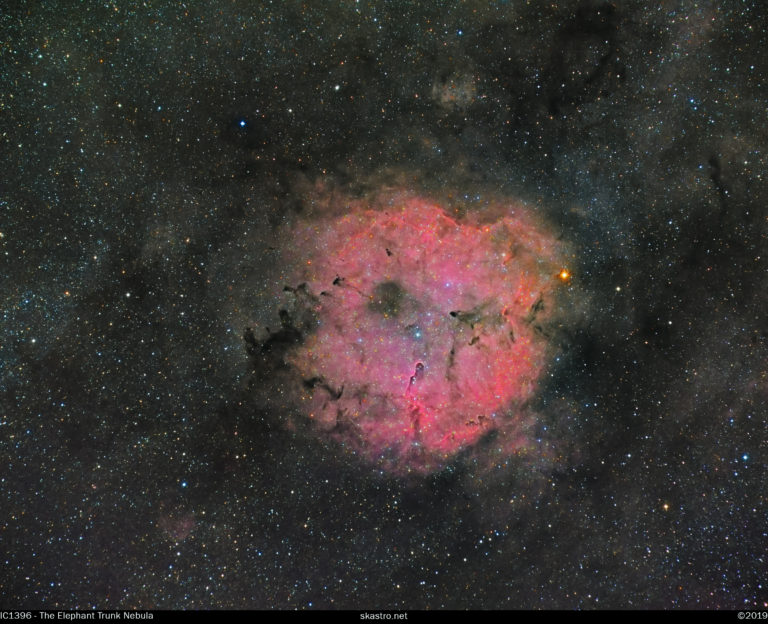Abell 1656 Abell 1656 – The Coma Cluster – is a cluster of galaxies in the constellation of Coma Berenices, located about 320-330 million lights years away. The cluster is dominated by two supergiant elliptical galaxies NGC 4874 and NGC 4889 which are visible in this image in the centre below the bright blue star (which is local to our own galaxy). NGC 4889 is the largest and most massive galaxy in the local universe and is vsoble in modest amateur telescopes despite the great distance. It contains the most massive black hole yet discovered. The galaxy itself is estimated to have more than 1000 times the mass of opur own Milky Way galaxy. Image Technical Data Image acquired spring 2020 (during the Coronavirus lockdown) in my backyard in Nottingham, UK. It was acquired with TEC 140 refractor (with field flattener) with Atik460 CCD camera and Astrodon LRGB Gen2 E…
IC1396 IC1396 – “the Elephant’s Trunk Nebula” is a huge emission nebula in the constellation of Cepheus, about 2500 light years away. It has a huge angular diameter of about 2 x 3 degrees so it requires a wide field telescope/lens to capture it in its entirety. It is a very popular imaging target both in a wide field setting like this picture and also as close up views of the “trunk” that you can see in the image at the 6 o’clock position. RGB only version Annotated Version Image Technical Data Image data acquired September 13th 2019 from my backyard in Nottingham, UK. This image was taken with my Samyang 135mm lens with G2-8300 CCD camera and Astrodon RGBHa filters on NEQ6 mount. Everything is 300s in this image and binned 1×1: Ha (3nm) x 13; Red x 12; Green x 8; Blue x 14
Sh2-202 This image shows Sh2-202 glowing to the left of centre with the top of the Soul Nebula at the bottom. Several other Sharpless Catalogue objects are also visible together with a few objects from the VdB catalogue. Sh2-202 Annotated Image Technical Data This image was captured from my back yard with my widefield rig consisting of my Samyang 135mm lens with Moravian Instruments G2-8300 CCD camera and Astrodon RGBHa filters. I used my NEQ6 mount. The data was acquired when the object was overhead from Nottingham UK on 29 November 2019. All data acquired in one imaging run and all exposures binned 1×1 and 300seconds: Ha(3nm) 180 mins, Red>50mins, Blue>45mins,Green>45mins I hope you like it!
I have completed several images of the famous Triangulum Galaxy – M33, over the years. This is one of the most photographed objects in the sky and with good reason; it is a beautiful face on spiral galaxy that is the second closest major galaxy after Andromeda. It is bright and colourful and responds well to all types of imaging, whether with a DSLR or CCD, camera lens or telescope. It is probably the second “go to” target to photograph for astro photography beginners after the Andromeda galaxy. The image below is a version captured with the TEC 140 refractor and Atik 460 CCD camera and is the total of about 12 hours of LRGBHa data captured from my backyard observatory in Nottingham, UK in 2018. You can see it fills the frame very nicely. M33 The Triangulum Galaxy M33 Annotated M33 Inverted Image Technical Data Image acquired spring 2018…
The Horsehead Nebula in HaRGB A famous, indeed iconic nebula in the constellation Orion, The Horsehead was not even discovered until 1888 with the advent of astro photography. It is very faint to see visually with a telescope. The image above was captured with my TEC 140 refractor and Atik 460 CCD camera with Astrodon RGB and Ha(3nm) filters. It contains a total of 120 minutes of Ha data and 45 minutes each of RGB data, everything binned 1×1 with 5 minutes exposures.





